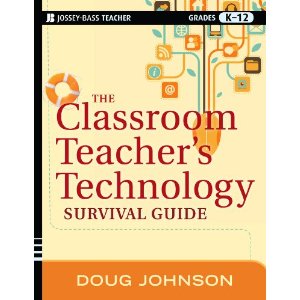There's an App for That
The Swiss Army Knife Approach
Head for the Edge, May/June 2013
Doug Johnson <doug0077@gmail.com>
For as long as I can remember I have carried a small Swiss Army knife in my pocket along with my change. It has a blade less than an inch and a half long, a screwdriver, a scissors, a toothpick, and tweezers. I’ve heard that members of the Swiss Army can use such a knife to stop an enemy in a dozen different ways, but I use mine primarily for opening boxes, trimming my finger nails, and cutting tags off things.
None of the knife’s tools is as good as having a dedicated tool. The scissors are small; the screwdriver is hard to use; the tweezers are flimsy. But each tool can do the job - and the tool is actually there, in my pocket, when I need it.
My point? I’ve marveled over the past three years at the rate iPads and other tablets have been adopted by both teachers and students. These marvelous devices seem to be the “Swiss Army knives” of educational technology, with a lot of “tools” packed into a small package.
When I read about tablet use in libraries, most commentators “ooh” and “aah” about library specific apps. And there is no denying that database specific (AccessMyLibrary, Article Search) apps, reference apps (Dictionary - Merriam Webster, Wikipedia), catalog access apps, and e-book reader apps (GoodReader, iBooks, Kindle, Nook) are very cool. It’s easy to imagine handing students iPads instead of having them sitting at terminals in our libraries.
But it is the Swiss Army knife abilities of the table that will have far-reaching consequences as libraries and schools adopt tablets. Yes, one can consume information in a wide range of formats - print, video, and audio, but users also create new content with the built-in camera(s), text editors and audio recorders, compete with a vast array of recreational and educational games, and communicate using e-mail, text, video conferencing and telephony applications. And this wide array of tools and functions, while none is extremely powerful, may be powerful enough to change the library and classroom technology device landscape.
For example, my guess is that your library has a few still and video digital cameras for check out. Why, when every phone and nearly every tablet has at least one camera? Yes, the high school photography class can justify using digital SLR cameras. A camera that can be used outdoors under extreme conditions might come in handy. But to have third graders shoot examples of symmetry in nature; for middle school students to snap scenes of economic problems in the community for a slideshow; or for high school kids to create a video demonstrating a cooking technique - for 99.9% of the uses we ask kids to make of cameras and photography - the camera in the tablet works great. It is simple to use. And it’s always there.
Libraries should be asking themselves why they should spend resources on a camera that only shoots digital stills and video and requires another device, a computer, to edit the images, when for a few dollars more, they can purchase a tablet that not only takes pictures and video, but edits them, and serves a multitude of other functions as well? Just how many megapixels does that fifth grader need?
Tablets are on the verge of replacing not just cameras but interactive whiteboards, student response systems, audio recorders, document cameras, calculators, and laptop carts. Unless one is writing a book, who really needs a full-sized keyboard or a full-fledged word processing program? (List three features in Word that you’d miss if you only used GoogleDocs.)
And the thing is, a lot of kids already have these devices, know how to use them, and will happily bring them to school if allowed to do so. Schools can focus tech spending on devices for kids whose families can’t afford them. Kids get to use what they personally know and like. Are we selling kids short by offering them a “Swiss Army knife” approach to educational technology? Replacing those high-powered devices that are difficult to use and to access for lots and lots of ubiquitous, multi-function, easy-to-use devices is a no-brainer. Go for access.
As a librarian, what is your role as tablets become more common in your school? Will you help select and manage educational “apps?” Will your library be the place staff and students go to get assistance learning how to use both the devices and the programs? Are the electronic resources your library offers “tablet-friendly?” Certainly your library is the place to use one’s tablet, given its comfortable seating, robust wireless access, and welcoming atmosphere.
Envision the library as the “Swiss Army Knife” of educational programs - services, resources, and support for every individual in your school. It’s an “appy” future for us.





Reader Comments